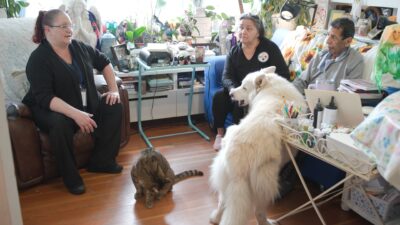Researchers have studied grief and grieving for decades. Many of their findings can be helpful to people who are grieving or providing support to the bereaved.
Below are brief summaries of some significant grief and loss research published in recent decades.
Resilience after loss
Dr. George Bonano
The author of The Other Side of Sadness: What the New Science of Bereavement Tells Us About Life After a Loss reports that most people are resilient: After a period of distress, typically several months long, the majority of bereaved people go on with their lives in healthy psychological and physical ways.
Styles of grief
Drs. Kenneth J. Doka and Terry Martin
After studying the diverse ways that people grieve, these experts identify three primary grieving “styles” unrelated to gender, age, or culture:
- Intuitive grievers express grief through words and emotions.
- Instrumental grievers express grief in action-oriented ways, channeling their grief into tasks.
- Blended grievers express their grief in both intuitive and instrumental ways. Most people fall into this category.
Importantly, these experts find that grief styles are a not a measure of love for the person who died. But differences in grieving styles may cause friction or misunderstandings, especially within families and other intimate networks.
For example, an intuitive griever may feel that an instrumental griever is not grieving “correctly” because they do not express their emotions. An instrumental griever may resent or avoid an intuitive griever’s outward display of emotion, such as tears.
Disenfranchised grief
Dr. Kenneth J. Doka
This researcher finds that some grief is not socially acknowledged or supported. People experiencing “disenfranchised grief” — often associated with non-death losses and the death of animal companions — may receive less support or respect than those grieving the death of a family member or close friend. Examples include:
- Not acknowledging the grief experienced after a miscarriage.
- Dismissing the grief felt when an older person dies after an extended illness.
- Failing to support those whose loved one died while engaged in a criminal activity.
- Attending to the grief of some family members but not others; for example, showing concern for parents whose child has died but not acknowledging the siblings’ grief.
In recent years, the concept of disenfranchised grief has been applied to many loss experiences, including those of Black Americans, people with developmental disabilities, and the LGBTQ+ community.
Post-traumatic growth
Drs. Richard Tedeschi and Lawrence Calhoun
These experts find that “post-traumatic growth” — a person’s ability to undergo positive change after a major life crisis, including the death of a loved one — can include:
- Seeing new possibilities in life.
- Forming deeper relationships.
- Identifying one’s own personal strengths.
- Experiencing spiritual and existential growth.
- Gaining a new appreciation for life.
Tasks of Mourning model
Dr. J. William Worden
This expert’s Task Model of Mourning outlines a series of tasks that must be accomplished during the grieving process. Unlike the five stages of grief (now considered outdated and inaccurate), these tasks are not ordered and can be revisited and reworked throughout the grieving process.
- Accept the reality of the loss. Acknowledge that a loved one has died.
- Experience the pain of grief. Open yourself to feelings of sorrow, anger, guilt, and loneliness — all normal reactions to loss. If needed, back away from experiencing pain from time to time, then re-approach these emotions when you are able to handle them effectively.
- Adjust to life without the deceased. Make external, internal, and spiritual adjustments so you can move forward.
- External adjustments (roles and functioning) might include learning new skills such as mowing the lawn or balancing a checkbook, or adjusting to daily activities, such as eating dinner without the deceased.
- Internal adjustments (sense of self, self-efficacy) may include grappling with difficult internal questions, such as, “Who am I now without my loved one?”
- Spiritual adjustments (shattered assumptions, beliefs, values) are required when a loss shatters the idea that the world is safe and predictable. The loss may strengthen spiritual and religious beliefs, raise questions, or create internal conflict.
- Find an enduring connection while embarking on a new life. In most cases, thinking about the deceased, taking part in rituals of remembrance, or even wearing a loved one’s favorite article of clothing can help you maintain a lasting connection while moving ahead with your life.
However, this is not helpful for everyone; in some cases, it can be destructive or damaging. For example, if the relationship with the deceased was unhealthy or abusive, maintaining bonds may continue those unhealthy patterns. If the effort to stay connected becomes all-consuming, it can interfere with activities of daily living or keep you from forming healthy relationships.
Finding meaning
Dr. Robert Niemeyer
This researcher, and many others, suggests that one part of adapting to loss is finding ways to make meaning of it.
Many grievers turn to their faith or spiritual beliefs, but meaning-making can take many forms, such as advocating for others, like Mothers Against Drunk Driving, or creating a memorial, such as a monument or a scholarship fund. Meaning-making also can be more personal, such as dedicating time or resources to a cause that was important to the deceased.
Dual process model
Drs. Henk Stroebe and Margaret Schut
These experts theorize that individuals coping with bereavement move back and forth between “loss-oriented” and “restoration-oriented” responses as they adjust to their loss. This allows the griever to experience the strong emotions and other impacts of grief while also continuing with daily activities.
- Loss-oriented responses include experiencing the pain of loss and breaking ties with the deceased, the intrusion of grief into daily life (even well after the loss), letting go while also building enduring connections to the deceased, and denying or avoiding restoration changes.
- Restoration-oriented responses include attending to life changes, doing new things, distracting yourself from grief, denying or avoiding grief, and settling into new roles, identities, and relationships.


